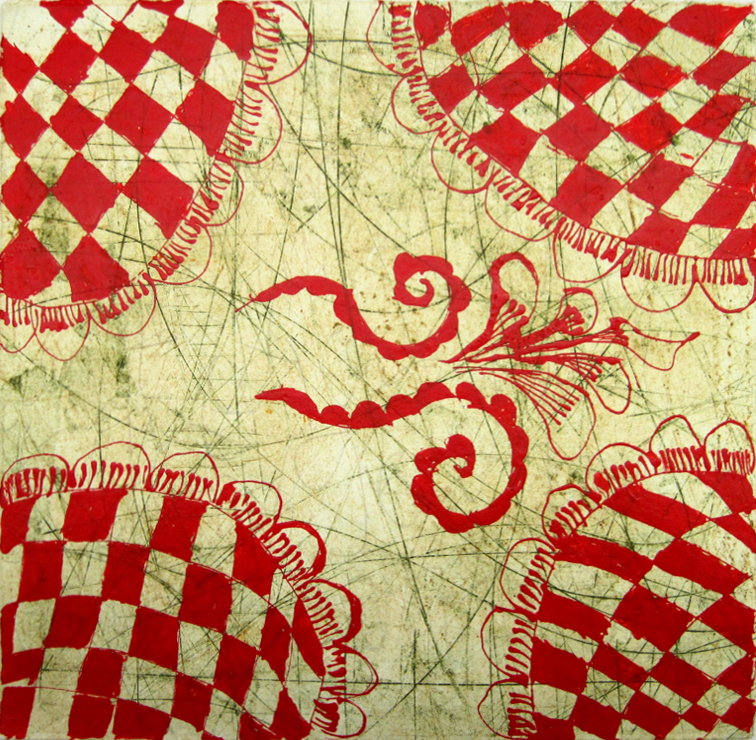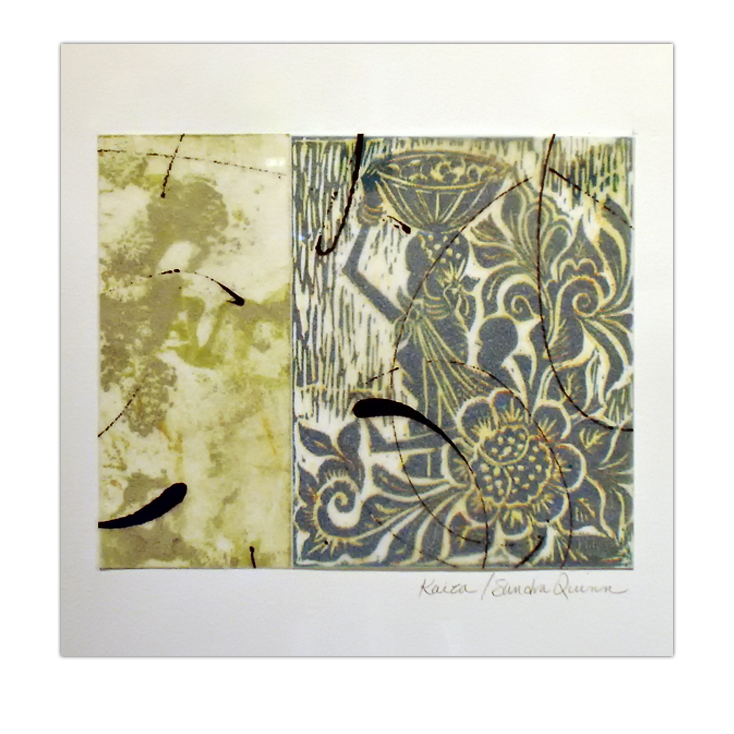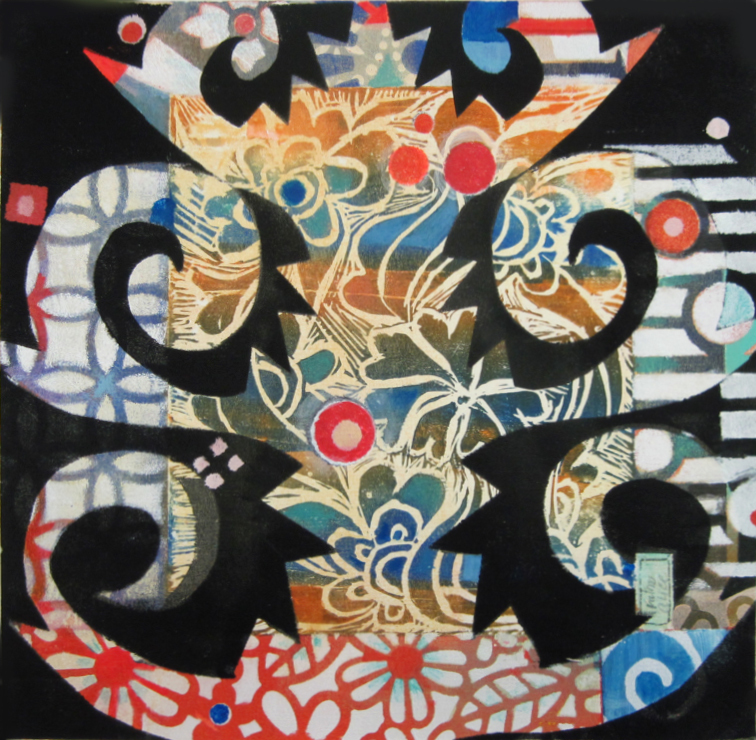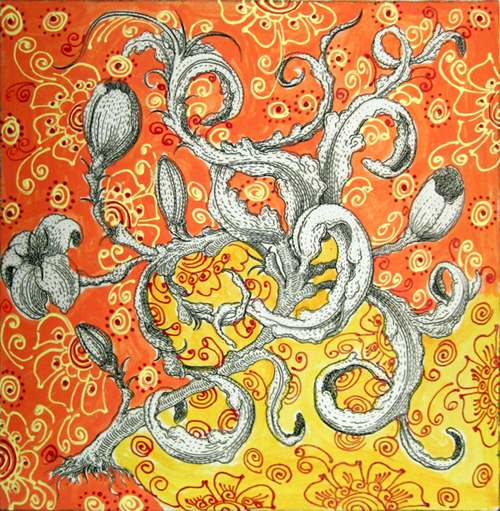There is a kind of collaborative art show that is born of great ideas and good intentions and bred by creative energy and innovative processes. Everything is terrific except, unfortunately, the art.
Maybe it’s because more time was spent talking or scheming than on the art itself. Sometimes, the exciting ideas reach beyond the technical means of the artists, and sometimes they simply don’t translate into interesting works of art.
I have seen dozens of such shows, and most of them fall well short of the mark for various reasons.
“Dunia Moja/One World” at the Portland Public Library is not one of those shows.
There are two major reasons for why this show succeeds. First, the premise is simple and open-ended (“no rules!”). Second, the two sets of participating artists are seasoned professionals whose technical abilities are fully evident.
Stateside, we have the members of the Portland-based Peregrine Press. Fine art printmakers tend to be among the more technically sophisticated artists because of the demands of printing processes. Peregrine includes many of the finest printmakers in Maine.
For this project, the Maine artists exchanged prints with the artists of “Women Networking” in Zanzibar, Tanzania. The idea was to work on the print made by the artist from the other country.
The easy mistake would be to assume the 12 henna artists would not be as strong as their American counterparts, since they had only recently been introduced to the technique of block printing. But these henna artists are professionals and highly skilled in an art (primarily decorating women’s bodies) that has been around for many thousands of years. They are fantastic artists.
The story of how Peregrine Press co-founder Alice Spencer helped bring about this project on the heels of the Zanzibari artists’ “Henna Body Art to Canvas” project is fascinating. (You can read about it at the exhibition or online). Fortunately, Bates College purchased four of the gorgeous paintings from that project, and has loaned them to this exhibition. It’s easy to see how they might inspire an artist such as Spencer.
Once again, the henna artists delivered. The works in “One World” are really good.
A particularly strong work is an etching of a fantastical flowered vine by Steve Burt that was completed by Jamilia Mzee. By itself, Burt’s flora is eye-poppingly detailed, but Mzee’s divided decorative background weaves it back into the image using floral motifs and a brilliant formal gesture in which the lower quadrant reads as the inverse of the rest. It comprises red drawing on a yellow ground, whereas the upper portion is yellow and red drawing on an orange ground. (Like many of the works in the show, the drawing is done by the traditional henna technique using something like a pastry bag — only with paint instead of henna.)
The Burt/Mzee piece is one of the simplest in terms of collaboration because Mzee left Burt’s image completely intact.
My favorite pieces in the show are a pair of works by Zanzibari artist Fatma and Spencer. These remind me of Marsden Hartley’s 1914 “Portrait of a German Officer” paintings because of their boldly decorative elements carved into form by a black ground.
In the case of the Fatma/Spencer pieces, the black is superimposed over a colorful, floral block print that appears to have been first extended over the ground so that the curling black forms reach over the work of both artists. The reds, blues, greens, oranges and whites really pop, and actually reach back over the black to further complicate the relationship of positive and negative space.
The two groups of artists often assertively invade the work of the other. Several of the henna artists drew details to transform, for example, floral elements into birds. Some of the Peregrine artists actually cut the prints they received. (There are several 3D works in the show.) This reveals a particularly interesting process of making art in general — how an artist makes decisions about what to do in response to what has been done already.
One artist told me it took her two weeks of anxious consideration before she began to work on the print from her Zanzibari counterpart. Many of the artists thought long and hard before working on the prints they received, and it shows.
Other particularly noteworthy works include Kaiza Khamis Mohammad’s and Sandra Quinn’s elegant effort, in which Quinn cropped the figurative print and worked over it with an encaustic monotype; and Jessyca Broekman’s and Fatma’s piece, in which Fatma put forms like red checkered tablecloths in the corners and a centered bouquet over a minimal print of lightly-etched swooping lines over a parchment ground.
This installation is the most handsome I have seen in the library’s Lewis Gallery. In addition to the framed prints on the wall and the paintings, there are gorgeous Zanzibari kanga cloths hung on the huge wall above the gallery, documentary photographs and vitrines with some of the more sculptural works and even prints attached to each other to form star-shaped standing displays. The overall feel is sumptuous and sophisticated.
This is simply one of the most interesting shows I have seen in a long time — and the work stands up to the great efforts, intentions and ideas that made it happen in the first place.
Freelance writer Daniel Kany is an art historian who lives in Cumberland. He can be contacted at:
dankany@gmail.com
Copy the Story Link
Send questions/comments to the editors.






Success. Please wait for the page to reload. If the page does not reload within 5 seconds, please refresh the page.
Enter your email and password to access comments.
Hi, to comment on stories you must . This profile is in addition to your subscription and website login.
Already have a commenting profile? .
Invalid username/password.
Please check your email to confirm and complete your registration.
Only subscribers are eligible to post comments. Please subscribe or login first for digital access. Here’s why.
Use the form below to reset your password. When you've submitted your account email, we will send an email with a reset code.